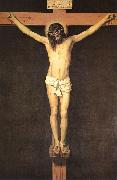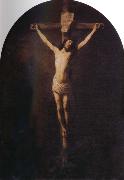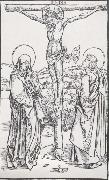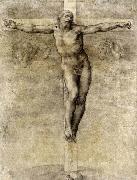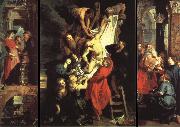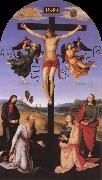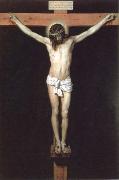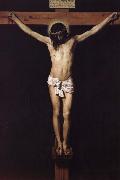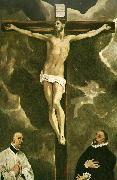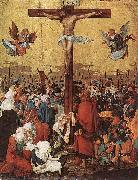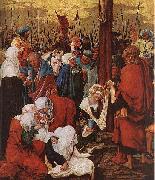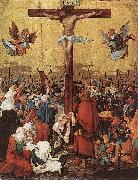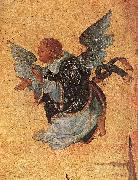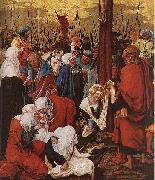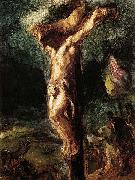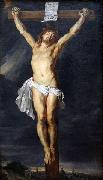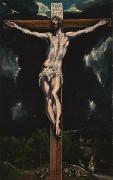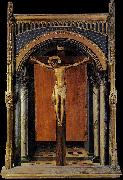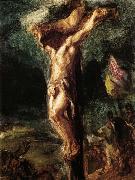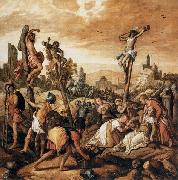Wholesale Oil Painting Reproductions No Minimum and Door to Door! |
|||||||||||
|
|
|||||||||||

|
|||||||||||
|
|
|
||||||||
All Diego Velazquez Oil Paintings |
||||||||
|
|
||||||||
|
|
||||||||
|
Artist Introduction: Spanish Baroque Era Painter, 1599-1660
Spanish painter. He was one of the most important European artists of the 17th century, spending his career from 1623 in the service of Philip IV of Spain. His early canvases comprised bodegones and religious paintings, but as a court artist he was largely occupied in executing portraits, while also producing some historical, mythological and further religious works. His painting was deeply affected by the work of Rubens and by Venetian artists, especially Titian, as well as by the experience of two trips (1629-31 and 1649-51) to Italy. Under these joint influences he developed a uniquely personal style characterized by very loose, expressive brushwork. Although he had no immediate followers, he was greatly admired by such later painters as Goya and Manet |
||||||||
|
|
||||||||
|
Christ on the Cross Painting ID:: 759 |
1632
Museo del Prado, Madrid
|
|||||||
Height Width |
INS/CM Quality |
|||||||
|
X |
| |||||||
|
|
||||||||
All REMBRANDT Harmenszoon van Rijn Oil Paintings |
||||||||
|
|
||||||||
|
|
||||||||
|
Artist Introduction: Born 1606, Died 1669.One of the great Dutch painters and printmakers of the 17th century, Rembrandt van Rijn is best known for his expressive use of light and shadow (also called chiaroscuro) in his many portraits. Raised in Leiden, he studied with Pieter Lastman (1583-1633) in Amsterdam, then returned to Leiden around 1625 and set up shop as a teacher and portrait artist. Sometime between 1630 and 1632 Rembrandt relocated to Amsterdam, where he spent the rest of his career. Though he had his detractors (some of whom considered him coarse and "low born"), Rembrandt was successful and famous during his lifetime, though he fell on financial hard times in his later years. He was a master printer and produced hundreds of group portraits and historical paintings, including The Anatomy Lesson of Dr. Tulp (1632), The Military Company of Captain Frans Banning Cocq (1642) and Aristotle with a Bust of Homer (1653). His portraits -- including a lifelong trail of intriguing and rather frank self-portraits -- reveal his interest in psychological study and continue to be admired as landmarks in Western art. The Military Company of Captain Frans Banning Cocq is also known as "The Night Watch" because it was thought the painting depicted a nighttime scene. When the painting was cleaned in the 1940s it became obvious that it depicted a daytime scene... He married Saskia van Ulenburgh (also Uylenburgh) in 1634. |
||||||||
|
|
||||||||
|
|
Christ on the Cross Painting ID:: 34420 |
mk93
1631
Oil on canvas placed on panel
36 1/2x28 1/2in
Church of Le Mas d'Agenais,
France
|
||||||
Height Width |
INS/CM Quality |
|||||||
|
X |
| |||||||
|
|
||||||||
All Albrecht Durer Oil Paintings |
||||||||
|
|
||||||||
|
|
||||||||
|
Artist Introduction: b.May 21, 1471, Imperial Free City of Nernberg [Germany]
d.April 6, 1528, Nernberg
Albrecht Durer (May 21, 1471 ?C April 6, 1528) was a German painter, printmaker and theorist from Nuremberg. His still-famous works include the Apocalypse woodcuts, Knight, Death, and the Devil (1513), Saint Jerome in his Study (1514) and Melencolia I (1514), which has been the subject of extensive analysis and interpretation. His watercolours mark him as one of the first European landscape artists, while his ambitious woodcuts revolutionized the potential of that medium. D??rer introduction of classical motifs into Northern art, through his knowledge of Italian artists and German humanists, have secured his reputation as one of the most important figures of the Northern Renaissance. This is reinforced by his theoretical treatise which involve principles of mathematics, perspective and ideal proportions.
His prints established his reputation across Europe when he was still in his twenties, and he has been conventionally regarded as the greatest artist of the Renaissance in Northern Europe ever since. |
||||||||
|
|
||||||||
|
|
Christ on the Cross Painting ID:: 42259 |
mk168
220x133mm
|
||||||
Height Width |
INS/CM Quality |
|||||||
|
X |
| |||||||
|
|
||||||||
All Michelangelo Buonarroti Oil Paintings |
||||||||
|
|
||||||||
|
|
||||||||
|
Artist Introduction: b Caprese 1475 d Rome 1564
Born: March 6, 1475
Caprese, Italy
Died: February 18, 1564
Rome, Italy
Italian artist
Michelangelo was one of the greatest sculptors of the Italian Renaissance and one of its greatest painters and architects.
Early life
Michelangelo Buonarroti was born on March 6, 1475, in Caprese, Italy, a village where his father, Lodovico Buonarroti, was briefly serving as a Florentine government agent. The family moved back to Florence before Michelangelo was one month old. Michelangelo's mother died when he was six. From his childhood Michelangelo was drawn to the arts, but his father considered this pursuit below the family's social status and tried to discourage him. However, Michelangelo prevailed and was apprenticed (worked to learn a trade) at the age of thirteen to Domenico Ghirlandaio (1449?C1494), the most fashionable painter in Florence at the time.
After a year Michelangelo's apprenticeship was broken off. The boy was given access to the collection of ancient Roman sculpture of the ruler of Florence, Lorenzo de' Medici (1449?C1492). He dined with the family and was looked after by the retired sculptor who was in charge of the collection. This arrangement was quite unusual at the time.
Early works
Michelangelo's earliest sculpture, the Battle of the Centaurs (mythological creatures that are part man and part horse), a stone work created when he was about seventeen, is regarded as remarkable for the simple, solid forms and squarish proportions of the figures, which add intensity to their violent interaction.
Soon after Lorenzo died in 1492, the Medici family fell from power and Michelangelo fled to Bologna. In 1494 he carved three saints for the church of San Domenico. They show dense forms, in contrast to the linear forms which were then dominant in sculpture.
Rome
After returning to Florence briefly, Michelangelo moved to Rome. There he carved a Bacchus for a banker's garden of ancient sculpture. This is Michelangelo's earliest surviving large-scale work, and his only sculpture meant to be viewed from all sides.
In 1498 the same banker commissioned Michelangelo to carve the Piet?? now in St. Peter's. The term piet?? refers to a type of image in which Mary supports the dead Christ across her knees. Larger than life size, the Piet?? contains elements which contrast and reinforce each other: vertical and horizontal, cloth and skin, alive and dead, female and male.
Florence
On Michelangelo's return to Florence in 1501 he was recognized as the most talented sculptor of central Italy. He was commissioned to carve the David for the Florence Cathedral.
Michelangelo's Battle of Cascina was commissioned in 1504; several sketches still exist. The central scene shows a group of muscular soldiers climbing from a river where they had been swimming to answer a military alarm. This fusion of life with colossal grandeur henceforth was the special quality of Michelangelo's art.
From this time on, Michelangelo's work consisted mainly of very large projects that he never finished. He was unable to turn down the vast commissions of his great clients which appealed to his preference for the grand scale.
Pope Julius II (1443?C1513) called Michelangelo to Rome in 1505 to design his tomb, which was to include about forty life-size statues. Michelangelo worked on the project off and on for the next forty years.
Sistine Chapel
In 1508 Pope Julius II commissioned Michelangelo to decorate the ceiling of the chief Vatican chapel, the Sistine. The traditional format of ceiling painting contained only single figures. Michelangelo introduced dramatic scenes and an original framing system, which was his earliest architectural design. The chief elements are twelve male and female prophets (the latter known as sibyls) and nine stories from Genesis.
Michelangelo stopped for some months halfway along. When he returned to the ceiling, his style underwent a shift toward a more forceful grandeur and a richer emotional tension than in any previous work. The images of the Separation of Light and Darkness, and Ezekiel illustrate this greater freedom and mobility.
After the ceiling was completed in 1512, Michelangelo returned to the tomb of Julius and carved a Moses and two Slaves. His models were the same physical types he used for the prophets and their attendants in the Sistine ceiling. Julius's death in 1513 halted the work on his tomb.
Pope Leo X, son of Lorenzo de' Medici, proposed a marble facade for the family parish church of San Lorenzo in Florence to be decorated with statues by Michelangelo. After four years of quarrying and designing the project was canceled.
Medici Chapel
In 1520 Michelangelo was commissioned to execute the Medici Chapel for two young Medici dukes. It contains two tombs, each with an image of the deceased and two allegorical (symbolic) figures: Day and Night on one tomb, and Morning and Evening on the other.
A library, the Biblioteca Laurenziana, was built at the same time on the opposite side of San Lorenzo to house Pope Leo X's books. The entrance hall and staircase are some of Michelangelo's most astonishing architecture, with recessed columns resting on scroll brackets set halfway up the wall and corners stretched open rather than sealed.
Poetry
Michelangelo wrote many poems in the 1530s and 1540s. Approximately three hundred survive. The earlier poems are on the theme of Neoplatonic love (belief that the soul comes from a single undivided source to which it can unite again) and are full of logical contradictions and intricate images. The later poems are Christian. Their mood is penitent (being sorrow and regretful); and they are written in a simple, direct style.
Last Judgment
In 1534 Michelangelo left Florence for the last time, settling in Rome. The next ten years were mainly given over to painting for Pope Paul III (1468?C1549). |
||||||||
|
|
||||||||
|
|
Christ on the Cross Painting ID:: 52696 |
c. 1541 Black and white chalk, 368 x 268 mm |
||||||
Height Width |
INS/CM Quality |
|||||||
|
X |
| |||||||
|
|
||||||||
All Peter Paul Rubens Oil Paintings |
||||||||
|
|
||||||||
|
|
||||||||
|
Artist Introduction: Flemish Baroque Era Painter, 1577-1640
Peter Paul Rubens (June 28, 1577 ?C May 30, 1640) was a prolific seventeenth-century Flemish Baroque painter, and a proponent of an exuberant Baroque style that emphasized movement, color, and sensuality. He is well-known for his Counter-Reformation altarpieces, portraits, landscapes, and history paintings of mythological and allegorical subjects.
In addition to running a large studio in Antwerp which produced paintings popular with nobility and art collectors throughout Europe, Rubens was a classically-educated humanist scholar, art collector, and diplomat who was knighted by both Philip IV, king of Spain, and Charles I, king of England.
Rubens was a prolific artist. His commissioned works were mostly religious subjects, "history" paintings, which included mythological subjects, and hunt scenes. He painted portraits, especially of friends, and self-portraits, and in later life painted several landscapes. Rubens designed tapestries and prints, as well as his own house. He also oversaw the ephemeral decorations of the Joyous Entry into Antwerp by the Cardinal-Infante Ferdinand in 1635.
His drawings are mostly extremely forceful but not detailed; he also made great use of oil sketches as preparatory studies. He was one of the last major artists to make consistent use of wooden panels as a support medium, even for very large works, but he used canvas as well, especially when the work needed to be sent a long distance. For altarpieces he sometimes painted on slate to reduce reflection problems.
His fondness of painting full-figured women gave rise to the terms 'Rubensian' or 'Rubenesque' for plus-sized women. The term 'Rubensiaans' is also commonly used in Dutch to denote such women. |
||||||||
|
|
||||||||
|
|
Christ on the cross Painting ID:: 52961 |
mk225
1611-1614
420x310cm
|
||||||
Height Width |
INS/CM Quality |
|||||||
|
X |
| |||||||
|
|
||||||||
All RAFFAELLO Sanzio Oil Paintings |
||||||||
|
|
||||||||
|
|
||||||||
|
Artist Introduction: Italian High Renaissance Painter, 1483-1520
Italian painter and architect. As a member of Perugino's workshop, he established his mastery by 17 and began receiving important commissions. In 1504 he moved to Florence, where he executed many of his famous Madonnas; his unity of composition and suppression of inessentials is evident in The Madonna of the Goldfinch (c. 1506). Though influenced by Leonardo da Vinci's chiaroscuro and sfumato, his figure types were his own creation, with round, gentle faces that reveal human sentiments raised to a sublime serenity. In 1508 he was summoned to Rome to decorate a suite of papal chambers in the Vatican. The frescoes in the Stanza della Segnatura are probably his greatest work; the most famous, The School of Athens (1510 C 11), is a complex and magnificently ordered allegory of secular knowledge showing Greek philosophers in an architectural setting. The Madonnas he painted in Rome show him turning away from his earlier work's serenity to emphasize movement and grandeur, partly under Michelangelo's High Renaissance influence. The Sistine Madonna (1513) shows the richness of colour and new boldness of compositional invention typical of his Roman period. He became the most important portraitist in Rome, designed 10 large tapestries to hang in the Sistine Chapel, designed a church and a chapel, assumed the direction of work on St. Peter's Basilica at the death of Donato Bramante, |
||||||||
|
|
||||||||
|
|
Christ on the cross Painting ID:: 55640 |
mk243
1503
279x166cm
Oil on canvas
|
||||||
Height Width |
INS/CM Quality |
|||||||
|
X |
| |||||||
|
|
||||||||
All Simone Martini Oil Paintings |
||||||||
|
|
||||||||
|
|
||||||||
|
Artist Introduction: 1283-1344
Italian
Simone Martini Locations
He was a major figure in the development of early Italian painting and greatly influenced the development of the International Gothic style. It is thought that Martini was a pupil of Duccio di Buoninsegna, the leading Sienese painter of his time. His brother-in-law was the artist Lippo Memmi. Very little documentation survives regarding Simone's life, and many attributions are debated by art historians. Simone Martini died while in the service of the Papal court at Avignon in 1344.
Simone was doubtlessly apprenticed from an early age, as would have been the normal practice. Among his first documented works is the Maest?? of 1315 in the Palazzo Pubblico in Siena. A copy of the work, executed shortly thereafter by Lippo Memmi in San Gimignano, testifies to the enduring influence Simone's prototypes would have on other artists throughout the fourteenth century. Perpetuating the Sienese tradition, Simone's style contrasted with the sobriety and monumentality of Florentine art, and is noted for its soft, stylized, decorative features, sinuosity of line, and unsurpassed courtly elegance. Simone's art owes much to French manuscript illumination and ivory carving: examples of such art were brought to Siena in the fourteenth century by means of the Via Francigena, a main pilgrimage and trade route from Northern Europe to Rome.
Simone's major works include the Maest?? (1315) in the Palazzo Pubblico in Siena, St Louis of Toulouse Crowning the King at the Museo di Capodimonte in Naples (1317), the S. Caterina Polyptych in Pisa (1319) and the Annunciation and two Saints at the Uffizi in Florence (1333), as well as frescoes in the Chapel of St. Martin in the lower church of the Basilica of San Francesco d'Assisi. Francis Petrarch became friend with Simone while in Avignon, and two of his sonnets make reference to a portrait of Laura de Noves he supposedly painted for the poet.
|
||||||||
|
|
||||||||
|
|
Christ on the Cross Painting ID:: 55917 |
mk247
c.1340,tempera and gold on panel,9x5in,24x13cm,fogg art museum,cambridge,MA,USA |
||||||
Height Width |
INS/CM Quality |
|||||||
|
X |
| |||||||
|
|
||||||||
All Diego Velazquez Oil Paintings |
||||||||
|
|
||||||||
|
|
||||||||
|
Artist Introduction: Spanish Baroque Era Painter, 1599-1660
Spanish painter. He was one of the most important European artists of the 17th century, spending his career from 1623 in the service of Philip IV of Spain. His early canvases comprised bodegones and religious paintings, but as a court artist he was largely occupied in executing portraits, while also producing some historical, mythological and further religious works. His painting was deeply affected by the work of Rubens and by Venetian artists, especially Titian, as well as by the experience of two trips (1629-31 and 1649-51) to Italy. Under these joint influences he developed a uniquely personal style characterized by very loose, expressive brushwork. Although he had no immediate followers, he was greatly admired by such later painters as Goya and Manet |
||||||||
|
|
||||||||
|
|
christ on the cross Painting ID:: 56060 |
mk247
c.1632 ,oil on canvas,98.375x66.875 in,25x170 cm ,museo del prado,madrid,spain |
||||||
Height Width |
INS/CM Quality |
|||||||
|
X |
| |||||||
|
|
||||||||
All Velasquez Oil Paintings |
||||||||
|
|
||||||||
|
|
||||||||
|
Artist Introduction: 1599-1660,Spanish painter. He was apprenticed to Francisco Herrera the Elder before being trained by Francisco Pacheco. His early works were mostly religious or genre scenes. After arriving in Madrid in 1623, he painted a portrait of Philip IV that won him immediate success and an appointment as court painter. His position gave him access to the royal collections, including works by Titian, who exerted the greatest influence on his style. In his portraits from this period, only the faces and hands of the figures are accentuated, and the dark figures stand out against a light background. A visit to Italy (1629 ?C 31) further developed his style, and on his return to Madrid he entered his most productive period. Velazquez created a new type of informal royal portrait for Philip hunting lodge, and his portraits of court dwarfs display the same discerning eye as those of his royal subjects. On a second visit to Rome (1649 ?C 51) he painted a portrait of Pope Innocent X. The powerful head, brilliant combinations of crimson of the curtain, chair, and cope are painted with fluent technique and almost imperceptible brushstrokes that go far beyond the late manner of Titian and announce the last stage in Velazquez development. This portrait was copied innumerable times and won him immediate and lasting renown in Italy. In his last years he created his masterpiece, Las Meninas (The Maids of Honour, 1656). In this casual scene, the artist is shown painting the king and queen in the presence of the infanta Margarita and her attendants; the nearly life size figures are painted in more or less detail according to their relation to the central figure of the infanta and to the source of light, creating a remarkable illusion of reality never surpassed by Velazquez or any other artist of his age. He is universally acknowledged as one of the giants of Western art. |
||||||||
|
|
||||||||
|
|
Christ on the Cross Painting ID:: 59552 |
mk267 1631 years linen canvas 248 x 169 cm Prado Museum Madrid |
||||||
Height Width |
INS/CM Quality |
|||||||
|
X |
| |||||||
|
|
||||||||
All El Greco Oil Paintings |
||||||||
|
|
||||||||
|
|
||||||||
|
Artist Introduction: Greek-born Spanish Mannerist Painter, 1541-1614
Considered a representative of late Renaissance Spanish art, El Greco was actually born in Greece, on the island of Crete. After studying in Venice under Titian, El Greco settled in Toledo, Spain in 1577. At the time he was wildly popular, his emotionally religious paintings being just the ticket for the hometown of the Spanish Inquisition. After his death his work was largely ignored until the beginning of the 20th century; now he considered one of the inspired geniuses of Western art. His distinctive style features bold shapes and colors, with elongated and slightly distorted figures.
In Toledo El Greco was in constant demand and liked living large: he maintained a private orchestra to accompany his meals. |
||||||||
|
|
||||||||
|
|
christ on the cross Painting ID:: 64055 |
painted 1590-1600,cossio,c. 1580,mayer
98x70
the louvre, paris |
||||||
Height Width |
INS/CM Quality |
|||||||
|
X |
| |||||||
|
|
||||||||
All Albrecht Altdorfer Oil Paintings |
||||||||
|
|
||||||||
|
|
||||||||
|
Artist Introduction: German
1480-1538
Albrecht Altdorfer Galleries
He most often painted religious scenes, but is mainly famous as the first frequent painter of pure landscape, and also compositions dominated by their landscape. Taking and developing the landscape style of Lucas Cranach the Elder, he shows the hilly landscape of the Danube valley with thick forests of drooping and crumbling firs and larches hung with moss, and often dramatic colouring from a rising or setting sun. His Landscape with footbridge (National Gallery, London) of 1518-20 is claimed to be the first pure landscape in oil. He also made many fine finished drawings, mostly landscapes, in pen and watercolour. His best religious scenes are intense, sometimes verging on the expressionistic, and often depict moments of intimacy between Christ and his mother, or others. His most famous religious artwork is the The Legend of St. Sebastian and the Passion of Christ that decorated the altar in the St. Florian monastery in Linz, Austria. He often distorts perspective to subtle effect. His donor figures are often painted completely out of scale with the main scene, as in paintings of the previous centuries. He also painted some portraits; overall his painted oeuvre was not large. |
||||||||
|
|
||||||||
|
|
Christ on the Cross Painting ID:: 75878 |
ca. 1520(1520)
wood
57.5 cm (22.6 in). Height: 75 cm (29.5 in).
|
||||||
Height Width |
INS/CM Quality |
|||||||
|
X |
| |||||||
|
|
||||||||
All Albrecht Altdorfer Oil Paintings |
||||||||
|
|
||||||||
|
|
||||||||
|
Artist Introduction: German
1480-1538
Albrecht Altdorfer Galleries
He most often painted religious scenes, but is mainly famous as the first frequent painter of pure landscape, and also compositions dominated by their landscape. Taking and developing the landscape style of Lucas Cranach the Elder, he shows the hilly landscape of the Danube valley with thick forests of drooping and crumbling firs and larches hung with moss, and often dramatic colouring from a rising or setting sun. His Landscape with footbridge (National Gallery, London) of 1518-20 is claimed to be the first pure landscape in oil. He also made many fine finished drawings, mostly landscapes, in pen and watercolour. His best religious scenes are intense, sometimes verging on the expressionistic, and often depict moments of intimacy between Christ and his mother, or others. His most famous religious artwork is the The Legend of St. Sebastian and the Passion of Christ that decorated the altar in the St. Florian monastery in Linz, Austria. He often distorts perspective to subtle effect. His donor figures are often painted completely out of scale with the main scene, as in paintings of the previous centuries. He also painted some portraits; overall his painted oeuvre was not large. |
||||||||
|
|
||||||||
|
|
Christ on the Cross Painting ID:: 77150 |
ca. 1520
cjr |
||||||
Height Width |
INS/CM Quality |
|||||||
|
X |
| |||||||
|
|
||||||||
All Albrecht Altdorfer Oil Paintings |
||||||||
|
|
||||||||
|
|
||||||||
|
Artist Introduction: German
1480-1538
Albrecht Altdorfer Galleries
He most often painted religious scenes, but is mainly famous as the first frequent painter of pure landscape, and also compositions dominated by their landscape. Taking and developing the landscape style of Lucas Cranach the Elder, he shows the hilly landscape of the Danube valley with thick forests of drooping and crumbling firs and larches hung with moss, and often dramatic colouring from a rising or setting sun. His Landscape with footbridge (National Gallery, London) of 1518-20 is claimed to be the first pure landscape in oil. He also made many fine finished drawings, mostly landscapes, in pen and watercolour. His best religious scenes are intense, sometimes verging on the expressionistic, and often depict moments of intimacy between Christ and his mother, or others. His most famous religious artwork is the The Legend of St. Sebastian and the Passion of Christ that decorated the altar in the St. Florian monastery in Linz, Austria. He often distorts perspective to subtle effect. His donor figures are often painted completely out of scale with the main scene, as in paintings of the previous centuries. He also painted some portraits; overall his painted oeuvre was not large. |
||||||||
|
|
||||||||
|
|
Christ on the Cross Painting ID:: 77682 |
Date ca. 1520(1520)
Medium wood
Dimensions Width: 57.5 cm (22.6 in). Height: 75 cm (29.5 in).
cyf |
||||||
Height Width |
INS/CM Quality |
|||||||
|
X |
| |||||||
|
|
||||||||
All Albrecht Altdorfer Oil Paintings |
||||||||
|
|
||||||||
|
|
||||||||
|
Artist Introduction: German
1480-1538
Albrecht Altdorfer Galleries
He most often painted religious scenes, but is mainly famous as the first frequent painter of pure landscape, and also compositions dominated by their landscape. Taking and developing the landscape style of Lucas Cranach the Elder, he shows the hilly landscape of the Danube valley with thick forests of drooping and crumbling firs and larches hung with moss, and often dramatic colouring from a rising or setting sun. His Landscape with footbridge (National Gallery, London) of 1518-20 is claimed to be the first pure landscape in oil. He also made many fine finished drawings, mostly landscapes, in pen and watercolour. His best religious scenes are intense, sometimes verging on the expressionistic, and often depict moments of intimacy between Christ and his mother, or others. His most famous religious artwork is the The Legend of St. Sebastian and the Passion of Christ that decorated the altar in the St. Florian monastery in Linz, Austria. He often distorts perspective to subtle effect. His donor figures are often painted completely out of scale with the main scene, as in paintings of the previous centuries. He also painted some portraits; overall his painted oeuvre was not large. |
||||||||
|
|
||||||||
|
|
Christ on the Cross Painting ID:: 80503 |
ca. 1520(1520)
Medium wood
cyf |
||||||
Height Width |
INS/CM Quality |
|||||||
|
X |
| |||||||
|
|
||||||||
All Albrecht Altdorfer Oil Paintings |
||||||||
|
|
||||||||
|
|
||||||||
|
Artist Introduction: German
1480-1538
Albrecht Altdorfer Galleries
He most often painted religious scenes, but is mainly famous as the first frequent painter of pure landscape, and also compositions dominated by their landscape. Taking and developing the landscape style of Lucas Cranach the Elder, he shows the hilly landscape of the Danube valley with thick forests of drooping and crumbling firs and larches hung with moss, and often dramatic colouring from a rising or setting sun. His Landscape with footbridge (National Gallery, London) of 1518-20 is claimed to be the first pure landscape in oil. He also made many fine finished drawings, mostly landscapes, in pen and watercolour. His best religious scenes are intense, sometimes verging on the expressionistic, and often depict moments of intimacy between Christ and his mother, or others. His most famous religious artwork is the The Legend of St. Sebastian and the Passion of Christ that decorated the altar in the St. Florian monastery in Linz, Austria. He often distorts perspective to subtle effect. His donor figures are often painted completely out of scale with the main scene, as in paintings of the previous centuries. He also painted some portraits; overall his painted oeuvre was not large. |
||||||||
|
|
||||||||
|
|
Christ on the Cross Painting ID:: 80548 |
ca. 1520(1520)
Medium wood
cyf |
||||||
Height Width |
INS/CM Quality |
|||||||
|
X |
| |||||||
|
|
||||||||
All Eugene Delacroix Oil Paintings |
||||||||
|
|
||||||||
|
|
||||||||
|
Artist Introduction: French Romantic Painter, 1798-1863
For 40 years Eugene Delacroix was one of the most prominent and controversial painters in France. Although the intense emotional expressiveness of his work placed the artist squarely in the midst of the general romantic outpouring of European art, he always remained an individual phenomenon and did not create a school. As a personality and as a painter, he was admired by the impressionists, postimpressionists, and symbolists who came after him.
Born on April 28, 1798, at Charenton-Saint-Maurice, the son of an important public official, Delacroix grew up in comfortable upper-middle-class circumstances in spite of the troubled times. He received a good classical education at the Lycee Imperial. He entered the studio of Pierre Narcisse Guerin in 1815, where he met Theodore Gericaul |
||||||||
|
|
||||||||
|
|
Christ on the Cross Painting ID:: 84657 |
Date 1845
Medium Oil on panel
Dimensions 37 x 25 cm (14.6 x 9.8 in)
cjr |
||||||
Height Width |
INS/CM Quality |
|||||||
|
X |
| |||||||
|
|
||||||||
All Peter Paul Rubens Oil Paintings |
||||||||
|
|
||||||||
|
|
||||||||
|
Artist Introduction: Flemish Baroque Era Painter, 1577-1640
Peter Paul Rubens (June 28, 1577 ?C May 30, 1640) was a prolific seventeenth-century Flemish Baroque painter, and a proponent of an exuberant Baroque style that emphasized movement, color, and sensuality. He is well-known for his Counter-Reformation altarpieces, portraits, landscapes, and history paintings of mythological and allegorical subjects.
In addition to running a large studio in Antwerp which produced paintings popular with nobility and art collectors throughout Europe, Rubens was a classically-educated humanist scholar, art collector, and diplomat who was knighted by both Philip IV, king of Spain, and Charles I, king of England.
Rubens was a prolific artist. His commissioned works were mostly religious subjects, "history" paintings, which included mythological subjects, and hunt scenes. He painted portraits, especially of friends, and self-portraits, and in later life painted several landscapes. Rubens designed tapestries and prints, as well as his own house. He also oversaw the ephemeral decorations of the Joyous Entry into Antwerp by the Cardinal-Infante Ferdinand in 1635.
His drawings are mostly extremely forceful but not detailed; he also made great use of oil sketches as preparatory studies. He was one of the last major artists to make consistent use of wooden panels as a support medium, even for very large works, but he used canvas as well, especially when the work needed to be sent a long distance. For altarpieces he sometimes painted on slate to reduce reflection problems.
His fondness of painting full-figured women gave rise to the terms 'Rubensian' or 'Rubenesque' for plus-sized women. The term 'Rubensiaans' is also commonly used in Dutch to denote such women. |
||||||||
|
|
||||||||
|
|
Christ on the Cross Painting ID:: 86458 |
17th century
Medium Oil on canvas
Dimensions 221 x 121 cm (87 x 47.6 in)
cyf |
||||||
Height Width |
INS/CM Quality |
|||||||
|
X |
| |||||||
|
|
||||||||
All GRECO, El Oil Paintings |
||||||||
|
|
||||||||
|
|
||||||||
|
Artist Introduction: Greek-born Spanish Mannerist Painter, 1541-1614
Greek painter, designer and engraver, active in Italy and Spain. One of the most original and interesting painters of 16th-century Europe, he transformed the Byzantine style of his early paintings into another, wholly Western manner. He was active in his native Crete, in Venice and Rome, and, during the second half of his life, in Toledo. He was renowned in his lifetime for his originality and extravagance and provides one of the most curious examples of the oscillations of taste in the evaluation of a painter,
|
||||||||
|
|
||||||||
|
|
Christ on the Cross Painting ID:: 86551 |
Oil on canvas
Dimensions 95.5 x 61 cm (37.6 x 24 in)
cyf |
||||||
Height Width |
INS/CM Quality |
|||||||
|
X |
| |||||||
|
|
||||||||
All Pedro Berruguete Oil Paintings |
||||||||
|
|
||||||||
|
|
||||||||
|
Artist Introduction: (c. 1450 - 1504) was a Spanish painter; his art is regarded as a transitional style between gothic and Renaissance. Born in Paredes de Nava, Spain, he went to Italy in 1480 and worked in Federigo da Montefeltro's court in Urbino, where he could see some works by Melozzo da Forle. He came back to Spain in 1482 and painted in several cities, such as Sevilla, Toledo and Ávila. He was the father of an important sculptor, Alonso Berruguete, considered the most important sculptor in Renaissance Spain.
|
||||||||
|
|
||||||||
|
|
Christ on the Cross Painting ID:: 86702 |
Date between 1493(1493) and 1499(1499)
Medium Oil on wood
Dimensions Height: 186 cm (73.2 in). Width: 131 cm (51.6 in).
cjr |
||||||
Height Width |
INS/CM Quality |
|||||||
|
X |
| |||||||
|
|
||||||||
All Eugene Delacroix Oil Paintings |
||||||||
|
|
||||||||
|
|
||||||||
|
Artist Introduction: French Romantic Painter, 1798-1863
For 40 years Eugene Delacroix was one of the most prominent and controversial painters in France. Although the intense emotional expressiveness of his work placed the artist squarely in the midst of the general romantic outpouring of European art, he always remained an individual phenomenon and did not create a school. As a personality and as a painter, he was admired by the impressionists, postimpressionists, and symbolists who came after him.
Born on April 28, 1798, at Charenton-Saint-Maurice, the son of an important public official, Delacroix grew up in comfortable upper-middle-class circumstances in spite of the troubled times. He received a good classical education at the Lycee Imperial. He entered the studio of Pierre Narcisse Guerin in 1815, where he met Theodore Gericaul |
||||||||
|
|
||||||||
|
|
Christ on the Cross Painting ID:: 88543 |
1845
Medium Oil on panel
Dimensions 37 x 25 cm (14.6 x 9.8 in)
cyf |
||||||
Height Width |
INS/CM Quality |
|||||||
|
X |
| |||||||
|
|
||||||||
All Joachim Beuckelaer Oil Paintings |
||||||||
|
|
||||||||
|
|
||||||||
|
Artist Introduction: 1535-1574
Flemish
Joachim Beuckelaer Galleries
b Antwerp, c. 1534; dAntwerp, c. 1574). Flemish painter. He came from an Antwerp family of obscure painters and seems to have spent his entire life there. He trained in the studio of Pieter Aertsen, who in 1542 had married Beuckelaers aunt; he became an independent master and also married in 1560. His earliest known work dates from that year, and his development can be followed closely to 1570. The example of Beuckelaers master remained decisive throughout his career. Not only did he take over Aertsens new repertory of secular subjects, he also completely adopted his stylistic idiom and manner of painting, so that it can be difficult to distinguish the two hands. Beuckelaer was, however, by no means a slavish imitator, and as regards execution he fully bears comparison with Aertsen. |
||||||||
|
|
||||||||
|
|
Christ on the Cross Painting ID:: 88991 |
1567(1567)
Medium Oil on wood
cyf |
||||||
Height Width |
INS/CM Quality |
|||||||
|
X |
| |||||||
|
|
||||||||
All Johann Koler Oil Paintings |
||||||||
|
|
||||||||
|
|
||||||||
|
Artist Introduction: (8 March 1826, in Vastemõisa near Suure-Jaani, Viljandi County, Estonia - 22 April 1899 in St. Petersburg, Russia) was an Estonian painter. He is considered to have been the first professional Estonian painter. He distinguished himself primarily by his portraiture and to a lesser extent by his landscape paintings. Some of his most notable pictures depict the Estonian rural life in the second half of the 19th Century.
Johann Köler was the seventh child born to a peasant family. Despite the poverty of the parents Köler managed to attend the elementary and the district schools in Viljandi. Then he attended a workshop of master painters in Cesis (then in Livonia).
In 1846, Köler travelled to St. Petersburg to work as a sign writer, where his talent was soon discovered. From 1848 to 1855 Johan Köler studied drawing and painting at the St. Petersburg Imperial Academy of Arts.
During 1857 Köler travelled to Paris via Berlin, later returned to Germany then travelled to the Netherlands and Belgium. In 1858, he travelled across the Alps to Milan, Geneva, Florence and Rome. There, he studied in a private academy and devoted his time to watercolor technique. In Rome during 1859 he presented his composition "Christ on the Cross".
Answering the call of the St. Petersburg Academy of Arts, Köler returned to the city in 1861. From 1862 to 1874 he was a teacher of the Grand Duchess Maria Aleksandrovna, the daughter of Czar Alexander II of Russia. In 1869-1870, he worked as a lecturer at the St. Petersburg Academy of Arts. From 1886 to 1889 Johan Köler worked in Vienna, Nice and Paris. |
||||||||
|
|
||||||||
|
|
Christ on the Cross Painting ID:: 93571 |
1857-1859
Medium oil
Dimensions 196 x 101 cm (77.2 x 39.8 in)
cjr |
||||||
Height Width |
INS/CM Quality |
|||||||
|
X |
| |||||||
|
|
||||||||
|
Prev Next
|
||||||||
|
|
||||||||
|
Related Paintings to Johann Koler :. |
||||||||
|
|
||||||||
|
CONTACT US |
